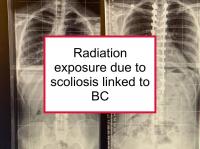Childhood and adolescent exposure to radiation of the chest, neck or back is known to increase the risk of breast cancer in adulthood. Such exposure is typically due to diagnosis and treatment of certain cancers and other conditions. Breast cancer caused, in part, by radiation exposure tends to occur at a younger age.
It is also more likely to have aggressive characteristics, with a higher proportion of HER2 overexpressing (HER2+) and hormone receptor negative (ER-/PR-) disease. For example, one study reported that women treated for Hodgkin's lymphoma at a young age had five times the rate of hormone receptor positive (ER+/PR+) and nine times the rate of ER-/PR- breast cancer compared to the general population.
While one might expect survivors of childhood cancers to have higher rates of cancer in adulthood, the same does not necessarily hold for those with spinal disorders who received diagnostic x-rays rather than radiation treatment. However, girls treated for scoliosis in childhood and early adolescence have been found to have sharply higher rates of breast cancer in adulthood. Part of the explanation for this may be that x-ray equipment in use decades ago resulted in higher radiation exposure than current equipment. However, a new study has reported that cancer rates are significantly higher among scoliosis patients even though the radiation dose was comparable to that using modern equipment.
Latest research finds scoliosis-associated radiation increases risk
The Danish study referenced at the beginning of this news story was designed to determine the rate of cancer in adolescent scoliosis patients treated 25 years ago. The study included 215 scoliosis patients treated during the period 1983 to 1990 who were requested to return for clinical and radiographic examination. Radiation information was available for 211 of the patients, and medical charts were available for 209. A total of 170 of the patients participated in the follow-up study and completed questionnaires. Cancer diagnoses were determined using medical records and interviews. The total radiation dose received during treatment and follow-up was calculated by a radiation physicist.
The average total radiation exposure was 0.8-1.4 millisievert (mSv) per examination and 2.4-5.6 mSv per year. Sixteen x-rays were taken during the treatment period, on average. Nine of the scoliosis patients developed cancer, mostly of the breast (3 cases) or endometrium (4 cases). They had sharply higher rates of cancer than the general Danish population; the 4.3% rate among the study participants was five times higher than the age-matched Danish population. The radiation dose received by participants in this study was comparable to patients using modern equipment, according to the authors. This is the first study to report increased rates of endometrial cancer in scoliosis patients. The authors comment that efforts should be made to reduce the radiation dose scoliosis patients receive both pre-operatively and during surgery.
Please see our article on protecting our daughters from breast cancer during childhood and puberty for more information.
